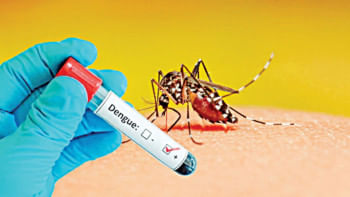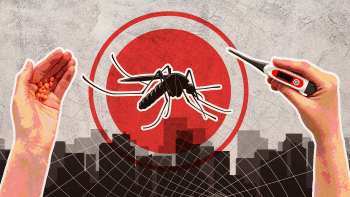Integrated Aedes management could help Bangladesh fight dengue

Despite years of battling dengue, Bangladesh still finds itself dealing with the crisis as lives continue to be cut tragically short. The Dengue Dynamic Dashboard for Bangladesh managed by the Directorate General of Health Services (DGHS) shows that, as of December 19, at least 557 people have died due to dengue in 2024, with a total of 99,805 cases recorded this year. This outbreak is the second deadliest in the country's history, following the 1,705 deaths and 321,179 cases recorded in 2023, making the case fatality rate (CFR) this year (0.52 percent), almost as high as last year's CFR (0.49 percent). It reveals not just a public health crisis but a failure to adapt quickly to a changing reality.
Despite effective measures, Bangladesh still faces major roadblocks in fighting dengue. For example, the effectiveness of mosquito control initiatives in Bangladesh has been inconsistent, contributing to the proliferation of Aedes mosquitoes. A monsoon survey conducted by the DGHS in 2023 revealed that the Aedes mosquito population in Dhaka's two city corporations nearly tripled over four years. This significant rise indicates lapses in sustained vector control measures. A comprehensive study revealed that while Dhaka city accounted for over half of the cases in 2019, by 2023, there was a nationwide surge with cases peaking earlier in the year.
However, through innovation, data-driven solutions, and smarter resource allocation, Bangladesh can turn the tide in this fight. The Integrated Aedes Management (IAM) approach, tested and approved by the World Health Organization (WHO) and successfully implemented in many countries, could be effective in controlling Aedes. IAM is a concrete data-driven and evidence-based initiative, implementing which involves a combination of vector control methods tailored to local contexts. This strategy includes four components: environmental management, biological control, chemical interventions, and community engagement and education. It aligns with the WHO's Integrated Vector Management (IVM) strategy, which advocates combining interventions to reduce reliance on any single method.
The environmental management of IAM focuses on the elimination of mosquito breeding sites, reducing favourable habitats. Regularly removing stagnant water from containers, flowerpots, discarded tires, and rooftops and enforcing strict construction site regulations is a very effective approach to the environmental management of mosquitoes. Singapore conducts a "10-minute mozzie wipeout" campaign to eliminate breeding grounds weekly. The US Environmental Protection Agency emphasises that targeting mosquito larvae in their breeding habitats is an effective and cost-efficient control method.
The biological control uses natural methods to suppress mosquito populations. The Wolbachia Bacteria Intervention strategy used in the biological measures introduces Wolbachia-infected Aedes mosquitoes to prevent virus replication. The technique has proven successful in reducing dengue cases by 77 percent in Indonesia's Yogyakarta City. In Brazil, the programme has curtailed dengue cases in the Aburra Valley region to a 20-year low.
The larvivorous fish technique uses fish like guppy fish that feed on mosquito larvae in ponds, canals or stagnant water sources. It will be a very cost-effective control for Bangladesh's rural and urban areas with large water reservoirs. India implements such programmes and has seen positive results. A study in India reported a 70-90 percent reduction in mosquito larvae populations through the introduction of guppy fish. Bangladesh has also used similar methods before.
Another very effective biological control is the Sterile Insect Technique method, which releases sterilised male mosquitoes to prevent reproduction. Successfully piloted in China, the method has reduced the Aedes population by up to 96 percent.
The chemical control targets adult mosquitoes and larvae effectively using insecticides. The Targeted Fogging strategy conducts early morning or evening fogging where Aedes mosquito density is high, identified through Geographic Information System-based surveillance. The method avoids indiscriminate spraying, which, of course, causes insecticide resistance. So, the technique achieves more sustainable results in mosquito population management.
The larvicide approach uses eco-friendly larvicides in breeding areas. It addresses resistance by alternating classes of insecticides. Studies in Dhaka found that 50 percent of mosquitoes are resistant to pyrethroids, emphasising the need for chemical rotation.
The last of the IAM framework is the community engagement and education approach, which empowers communities to participate actively in mosquito control. Part of it is behaviour change campaigns that focus on public education on preventing breeding sites, wearing protective clothing, and using repellents.
As another example, school-based programmes can educate students to be "mosquito warriors" by spreading awareness. Successful community-based models in Sri Lanka reduced dengue emergency admission by 60 percent. We must expand these programmes to reach more communities.
IAM offers sustainable, data-driven solutions to address Aedes mosquito density in Bangladesh. By combining environmental, biological, chemical, and community-based interventions, IAM ensures an adaptable approach to tackling dengue. For the framework to be successful, government commitment, technological integration, and community ownership are crucial.
ABM Uddin is analyst for the Senate Democratic Office at the Florida Legislature. He specialises in policies and politics around healthcare, ethics, and elections.
Views expressed in this article are the author's own.
Follow The Daily Star Opinion on Facebook for the latest opinions, commentaries and analyses by experts and professionals. To contribute your article or letter to The Daily Star Opinion, see our guidelines for submission.

 For all latest news, follow The Daily Star's Google News channel.
For all latest news, follow The Daily Star's Google News channel. 










Comments